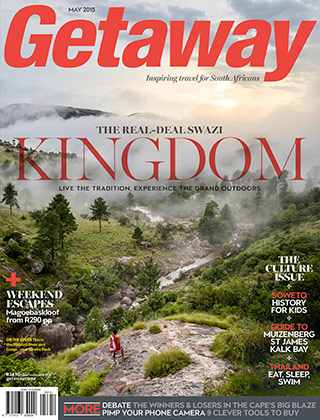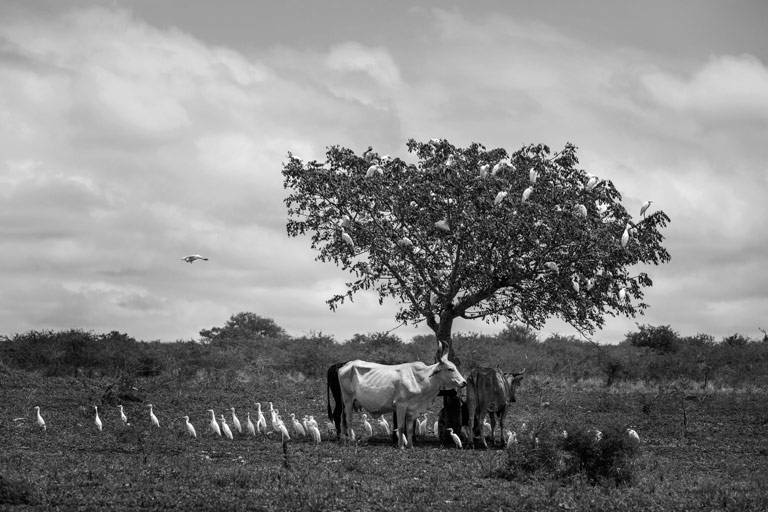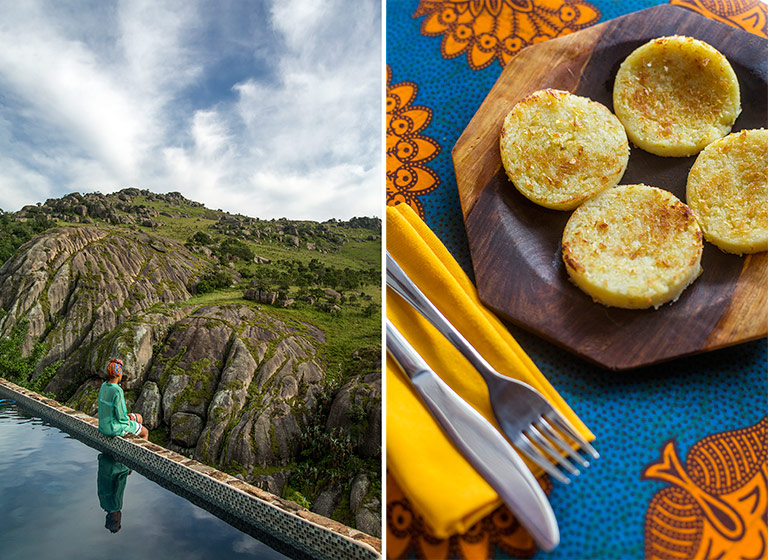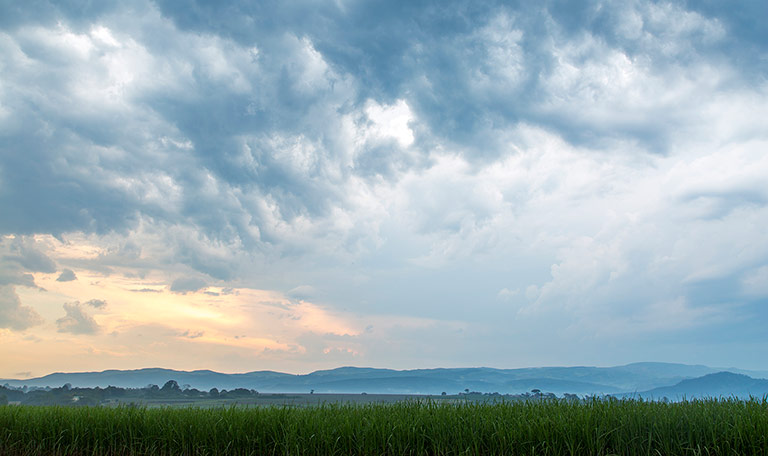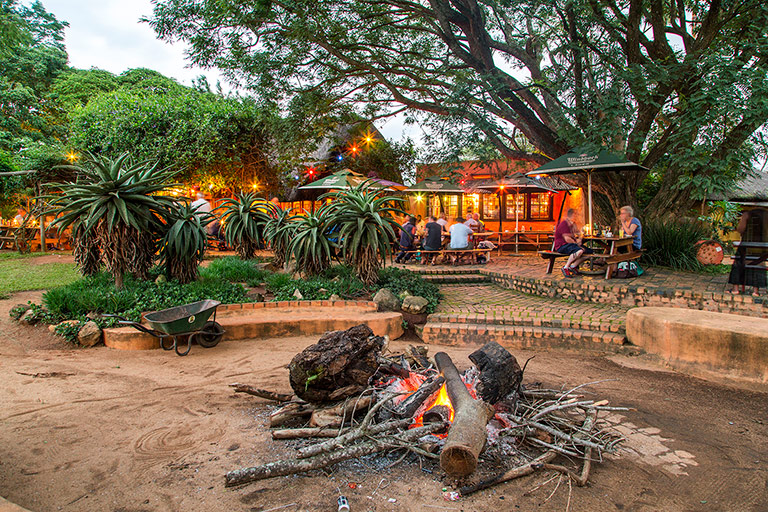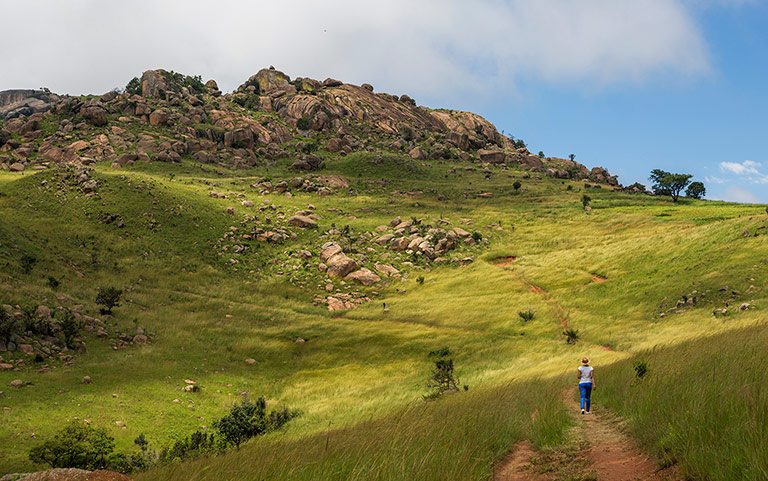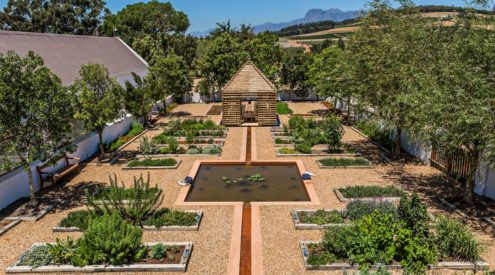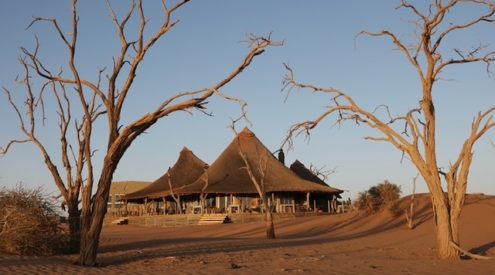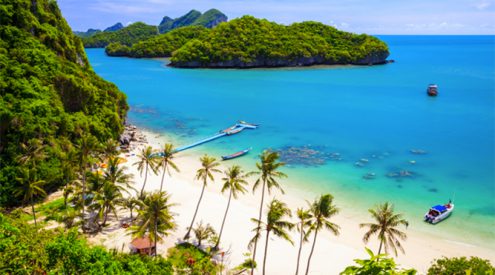Vuyi Qubeka goes to Swaziland expecting poverty and boiling resentment for its king. But what she finds is something quite different and very surprising. Photographs by Teagan Cunniffe.
Also read: Another viewpoint on Swaziland
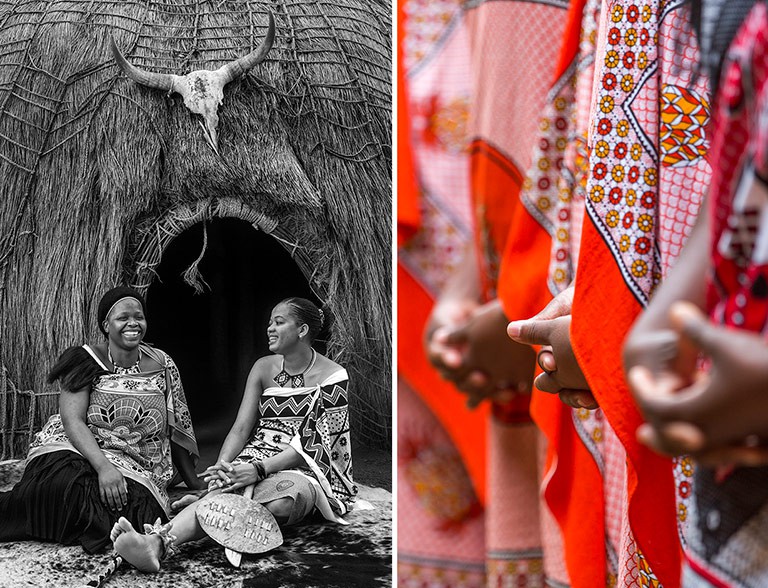
LEFT Hlobile (left) and Bachazile, both committed to preserving their culture, sit outside a hut at Mantenga Cultural Village. RIGHT Dancers in traditional Swazi cloth link their hands together while in song.
Mpisi gets down on his haunches, an arm resting on each knee, strong and steady on the balls of his feet. The brightly patterned cloth twisted at his waist and the emahlya (loin skin) attached above it falls between his exposed thighs. Squinting, he takes in the elements on the horizon. He stretches out a hand, collects a pile of stones, chooses one, and rises to his feet. In one smooth move, he lobs it into the centre of some bushes.
‘This tree is for healing different ailments in the body, for cleansing.’ He throws another. ‘We use the leaves of that one to brush our teeth when we sleep out in the bush.’ Another. ‘This one we burn when a family is blessed with the birth of a son.’
‘Which tree is for prosperity?’ I ask. He scans the thick woodland. ‘No, I don’t see it here, but there should be plenty along the highway as we continue on our way.’
Mpisi is thoughtful. He speaks honestly, and punctuates his speech with wise sayings. He is a warrior. He took the decision to join eNyatsi Yemswati (the King’s regiment) 10 years ago, at the age of 23. Ever since, he’s worked for Ingwenyama (the King) and lives alongside other warriors in Ludzidzini Royal Village.
‘The path I have chosen has taught me grace, respect and has shown me how to be a virtuous man.’
I speak in isiZulu, he in SiSwati. We understand one another just fine.
This was my first time in Swaziland. I was born and bred in Johannesburg and my impressions of the country were based solely on periodic glimpses of culture and news reports, mostly negative: stories about King Mswati III and his sovereign state, the extreme poverty, and the King’s voracious appetite for women. I expected to find sub-standard infrastructure, beggars at every turn and a country boiling with resentment for him. But things played out differently, as reality often does…
On entering the country, we passed undulating mountain plains, vast spaces of deep-olive greens and limes interspersed with small mud houses on big plots of land. The fields were quiet; only the gracious Lebombo Mountains, which run all the way to Mozambique, and the open road kept us company. Every now and then, I spotted an elderly woman walking along the road and I wondered where each was headed. It’s an odd thing to see someone that old trudging beside the hot tar of a seemingly unending road.

LEFT Warriors buying airtime at the petrol station. RIGHT Handmade candles with intricate patterns are produced by Swazi Candles.
Mbabane is the capital and ‘most urban’ city in Swaziland. We arrived midday, and it was peaceful and calm. Not one beggar. Someone later compared Mbabane to Sandton in Gauteng and it made me think about our own road intersections at home: an upsetting blend of heartbreak and displeasure. Of course, first impressions can be deceiving but that day in Mbabane it was month end and there was a quiet grace that I have never seen in Joburg.
We pushed on through. Cows cooled off on the side of the road. Goats trotted past them. Warriors in full traditional regalia bought airtime at a petrol station. A few days later we stayed at Mlilwane Wildlife Sanctuary (Swaziland’s first conservation area), which is surrounded by the Royal Botanical Gardens. At the centre of the park is a fire that has been burning for more than 50 years. Fire represents conservation in Swaziland.
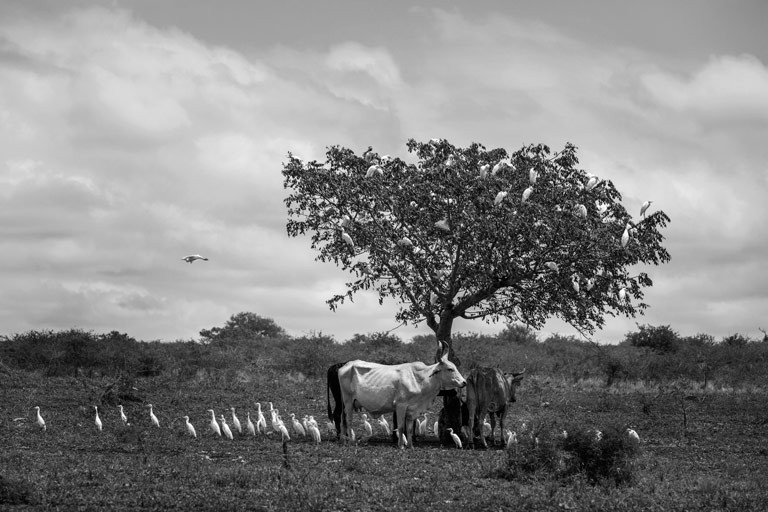
Cows and birds in perfect harmony take shade under a tree.
The next morning, I watched as a young Swazi man made me an omelette. All I said to him was, ‘Wow, you Swatis really take pride in your nation,’ and it opened the floodgates. He told me about the importance of the ceremonies, the regiment, and how it has prepared him for life. He emphasised the need to be in sync with nature and how the phases of the moon steer his people to success. Like many others I had spoken to, he reminded me that there is a sense of integration, pride and a deep appreciation and harmony between culture and tradition in Swaziland. The bank notes are etched with lidlabe (crown of feathers), the isihlangu (shield) and the sikhali (spear), princesses taking part in the Umhlanga (Reed Dance), flowers, corn and pineapples, lions, birds and elephants. The Swazi calendar is customised to include Swazi cultural icons: game, plants and the stars (lweti – a star to see in the dark when women begin work early).
The national flag can be seen everywhere. It is red, yellow and blue: red denotes battles of the past; yellow stands for resources; and blue for peace and stability. The shield in the centre represents protection of the country from enemies; the black and white for white and black people living in harmony – which brings me to Senator Mike Temple.
I met Senator Mike, or Mkhanyakudze (his Swazi name), at Mdzimba View, a popular hangout in Ezulwini, which he owns and described as the place for the best shisa nyama (braaied meat). He has passion for the Kingdom and is knowledgeable about the entire country and its regions. Senator Mike is a white, Swati-speaking man and a traditionalist. His family came to Swaziland in 1884. His father, a linguist, worked closely with the late King.
‘If you get the opportunity to speak to other Swazis like me – white – who were born here, have grown up here, and have lived here for 50, 60, 80 years… we learnt something from a very early age: that there was nothing like colour. We didn’t even understand what colour was. When I went to school in South Africa it was a shock to me to see.’
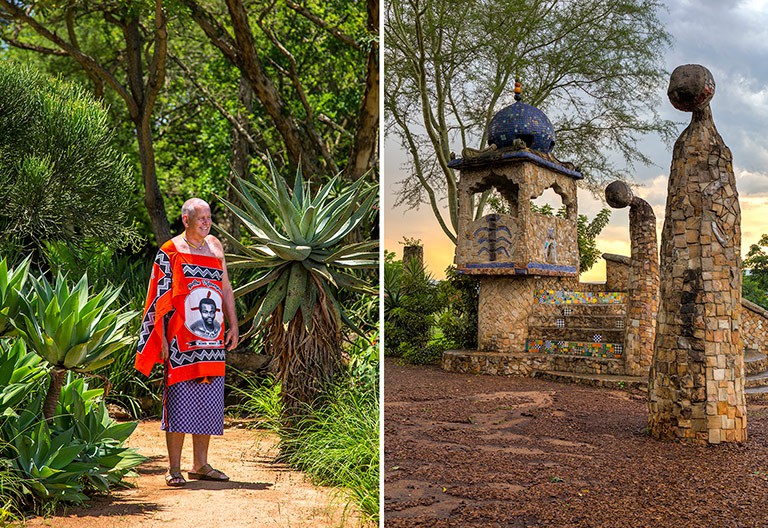
LEFT Senator Mike Temple stands in the garden at Malandela’s. RIGHT These huge stone sculptures are a striking feature at House on Fire.
He schooled there from 1966 to 1972, and attended university in SA in 1983. He saw the full face of apartheid. Mike was the one who had suggested we ask Mpisi to show us around their country, get one insider’s view.
Jiggs Thorne is in the same regiment as Mpisi and runs the House on Fire entertainment venue. He’s the founder and director the MTN Bushfire festival held every year on the premises. His siblings run Malandela’s restaurant, Malandela’s Bed & Breakfast, and All Out Africa (adventure tours) operating on their family farm. Jiggs was born in Swaziland. His parents came out from the UK in the 1960s. His nickname comes from his Swazi name, Mjikaphansi.
‘Our parents’ philosophy always was about getting involved and being a part of the community. That’s something that’s permeated through to us siblings. We believe there’s a relationship you have to have through business and all our projects have a strong social mandate that engages and reflects our beautiful country and people.’
When I think of culture and tradition, more often than not, I picture a person of colour. For as long as I can remember, I’ve always envisaged white people in big houses eating plentiful food at the dinner table, camping, or doing something in water, but never anything cultural. The smell of imphepho (incense), or the slaughtering of an animal just didn’t fit into the picture I had of the suburbs. In Swaziland, it feels different.
People are passionate about their culture, and feel more unified than back home. Many are passionate about their king, too. Like restaurateur Delores Godeffroy, who is baffled by the incessant foreign criticism of the King and the greater kingdom.
‘I don’t care what they say about Swaziland or Africa. I just love her unconditionally,’ she says. And about the King: ‘Who cares? All these big shots have mistresses; don’t point fingers at my king. He’s living within his culture. And I would think there are far more important things to talk about than my kings’ romantic life.’
‘They have their own mess, but they think they can sort the world. I just take the good stuff. Why must I confuse myself. They’re running away from their own problems, pointing the finger. Leave my Africa; it’s just fine.’
Marylyn Breero agrees. She co-owns with her husband the magnificent Ematjeni Luxury Bed & Breakfast on the edge of the mountain.
‘The monarchs in the UK, Netherlands and in Europe don’t get half the slack that our Kingdom gets, but because this is an African monarchy, people feel entitled to criticize and attack her with very little reason. I grew up here. Opposite us, across the river, lived a black Swazi family and we all struggled and experienced life together. I love my king, no matter what they say. We are a happy people. This is one of the most united people you will find left in this world. People should come see it for themselves.’
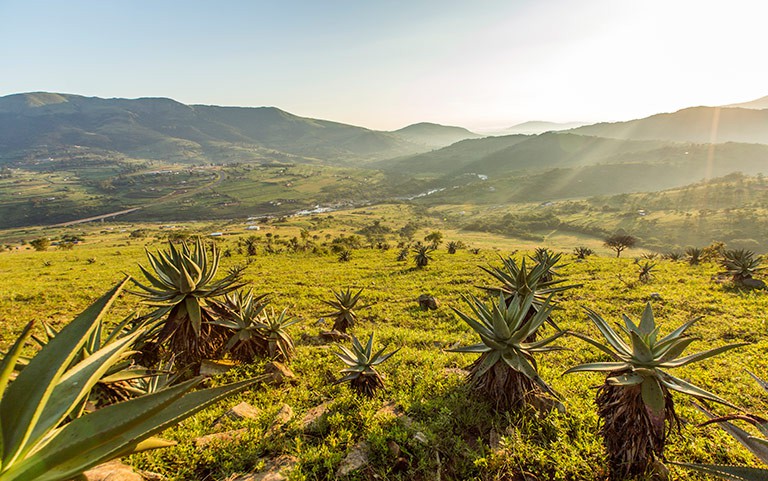
Swaziland’s land is vibrant with aloe found virtually everywhere. In the distant modest homes pepper the fields and winding roads.
It’s no secret that speaking ill of the King and the country has consequences, but I also experienced an openness about the country’s challenges. ‘Sometimes I’m fed up with being in Swaziland,’ says Delores. ‘Our people are not catching up fast enough, and the majority of my customers are foreign.’
‘For me the government maybe isn’t asking all the questions they should be asking,’ says Jiggs. ‘It comes down to priorities, where the spend is, health, and education. But that’s not everything and it’s not black and white. Growing up in Swaziland you appreciate the complexities of the situation in which we find ourselves, where we have these incredible people, so embracing, a culture that we can be proud of, and I tell you what, when you’re out there with the regiments, or at the Reed Dance, and the colour, and the song… it’s a very special feeling that one has. I’m a regimental member and some of the processes don’t sit well with me, and others do, but it’s good to be there. It’s important to me to be part of it,’ says Jiggs.
Back with Mpisi, we head east of Mbabane towards the newly built King Mswati III International Airport in the lowveld hamlet of Sikhuphe. The mission of the day is to see the wilderness of eastern Swaziland, the State-run Hlane Royal National Park, the largest protected natural area in the kingdom. The 22000 hectares of bushveld is home to white rhino, elephant, lion and rich birdlife. Swaziland has one of the strongest rhino protection laws and her parks boast some of the best security networks of any rhino sanctuary in Africa. The terrain is mostly flat, and dirt tracks criss-cross 1000-year-old fields. The highest density of nesting white-backed vultures (and eagles) in Africa can be found here, and we see them swirling overhead. Birds sing their songs, leaves dance in the wind, and crocodiles cool at the water’s edge.
Mpisi offers me a ‘tree of luck’, (khauyakudze), found at the front of many businesses across the country.
‘The thing about tradition is that it understands more than you do, and doesn’t separate itself from the laws of the universe and the wisdom of culture. You can’t presume to know more than it does; we do after all, come from that very celestial source,’ he says.
We make our way to Mantenga Cultural Village and Falls in the Mantenga Nature Reserve: a small-protected area just two kilometres off the main road in the Ezulwini Valley. Affectionately named Ligugu Lemaswati (Pride of the Swazi People) by King Mswati III, the institute showcases Swazi folklore, dance and music, rituals, art and crafts. Tourist attractions such as these may seem somewhat contrived – there are various dance routines at 11:30 and 15:15 every day, and in peak seasons there can be up to nine shows a day – but they offer visitors a chance to experience the lore of the past… and present.
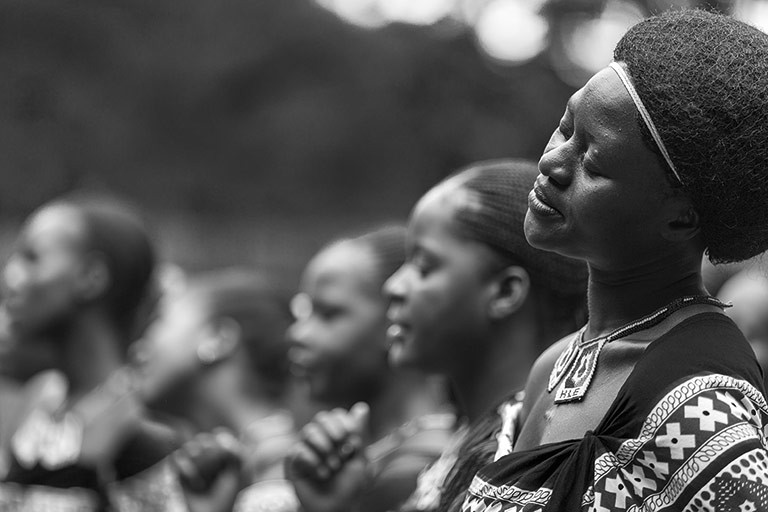
The spirit of Swazi culture can be felt at Mantenga Cultural Village. The head attire worn by the first woman indicates she is married.
During my early years in Soweto I experienced momentary impressions of my culture. Funerals and weddings were marked with spirited song, clapping, dance, and prayer; there was always prayer. Elders, old faces, friends and family came from all over to offer support; your burden was also the larger community’s. I remember when my younger brother Solomzi was born, my grandmother lit imphepho to beckon the company of our ancestors and blessings from our elders. Silence was honoured. These rituals were reserved for those occurrences.
I find myself sitting in a Swati rondavel thinking about this, a tear running down my face, lost in ingoma (song) and namadoda agidayo (men doing a powerful kicking dance). I recall my grandparents’ place in Ntabankulu in the Eastern Cape and its resemblance to this Kingdom, and Ndunduma in Clermont, Durban, where neighbours would host sessions together, to dance (sigide) in a big circle. I find myself lost in a trance. It’s as if I’ve been here before. I feel sad. Sad that I live so far away from where I come (and those who came before me). Confused at how western ways have become ‘the way’ – more appropriate than culture and tradition. But in that moment, I find contentment and pride in who I am. And I remember that there is an immutable strength in heritage.
Immerse yourself in the culture
MTN Bushfire is where you will see contemporary Swaziland in her full glory. Don’t miss it. It has an excellent line-up from around the world and is one of the continent’s top music festivals.
Also read: Why you can’t miss Bushfire festival this year
Ceremonies eSwazi is well known for events that promote cohesiveness in the nation, so try to go when one is happening. Umhlanga (Reed Dance), the most sacred national ceremony, takes place in August or September. Incwala (Kingship ritual), also known as the ‘First Fruits Ceremony’, is during summer solstice and varies depending on the lunar cycle. Dates and times for the events are released relatively late, as they are derived from ancestral astrology.
Mantenga Cultural Village offers a taste of Swazi culture. There are traditional dances at 11:15 and 15:15 every day and a tour of a typical Swazi village. Entrance is R100 per person.
King Sobhuza II Memorial Park gives insight into the Swazi temperament. Swazis recognise King Sobhuza as their first king. He was, in fact, not the first but he played a major role in developing the country, which he led to independence from the British without bloodshed.
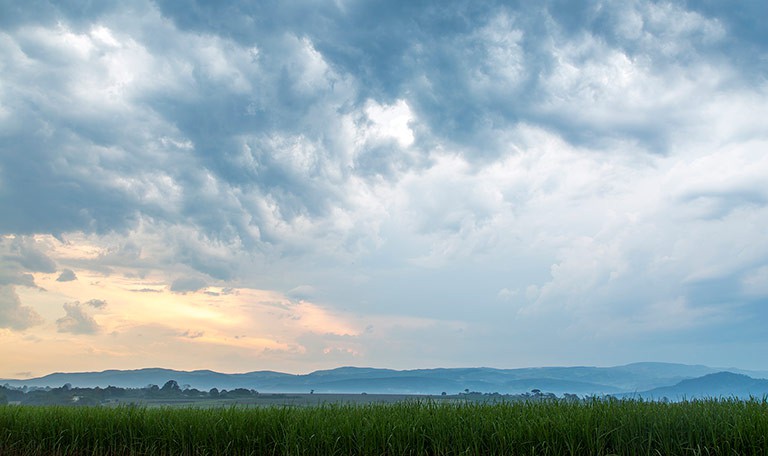
Stop and be romanced by the Swazi sunset (from anywhere really).
Outdoor activities
Hike Swaziland’s peaks – there are many. Ngwenya Mountain in Hhohho is the second highest in Swaziland at 1829m, while the Malabo Kop is the least treacherous at 1208m – it’s near Mhlambanyatsi in Manzini District. Nyonyane Mountain, also known as ‘Execution Rock’, has an exposed granite peak from which the beautiful Usushwana Valley can be seen. Visitors can also do several walks from Mlilwane Game Park.
Hlane Royal National Park is roughly 67km northeast of Manzini. Hlane means wilderness in SiSwati, and has the largest collection of game in all the country. Entrance is R40, under 13s free.
Mlilwane Wildlife Sanctuary offers guided mountain-bike tours, and is a wonderful way to experience this country’s large wild tracts and diverse wildlife in this sanctuary. The park was the first protected conservation area in Swaziland.
Sibebe Rock near Mbabane is a worthy challenge, and takes roughly four hours to hike. It’s the largest exposed granite pluton in the world, and the area around it is absolutely beautiful. Entrance is R20.
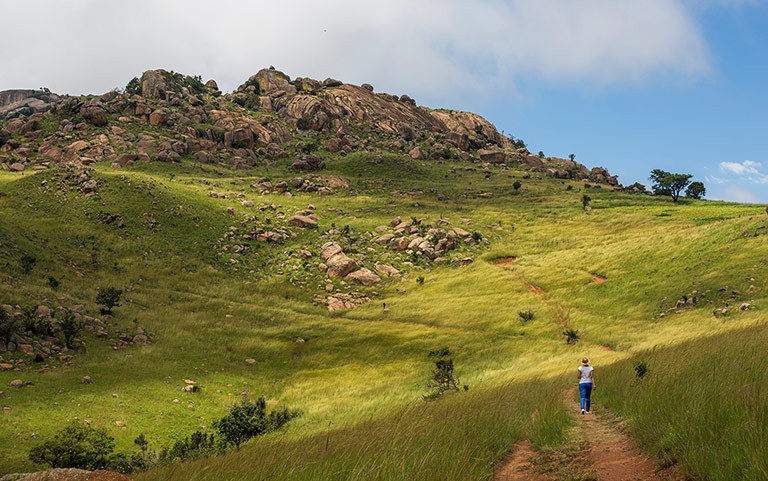
Sibebe mountain is the world’s largest, exposed plutonic rock, great for walkers and serious hikers.
How to get to Swaziland
The drive to Swaziland from Durban is beautiful and is about four hours to the Golela Border Post on the M2. From Johannesburg, it’s also about four hours to the Oshoek Border Post on the N17. To enter Swaziland at either border post, visitors are required to pay R50 per car. From Golela, you would take the MR8 and then the MR3 to Manzini. From Oshoek, it’s easier: just 18km down the MR3 from the border to Mbabane. All these main roads are in good condition. Alternatively, SA Airlink offers return flights from OR Tambo to Manzini’s Matsapha Airport starting from R3600.
What you need to know before visiting Swaziland
The Swazi Lilangeni (E) is the currency of Swaziland and is one-to-one with the rand. Many places don’t have credit or debit card facilities, so make sure you have access to ready cash. Prearrange accommodation where possible and pay by EFT. Some areas experience heavy fog all year, so be vigilant when driving. While the majority of roads are in great condition, be aware that there are some with large potholes – keep a sharp eye out. South African and African citizens don’t require a visa to enter the Kingdom, only a valid passport, and take along your vehicle papers just in case.
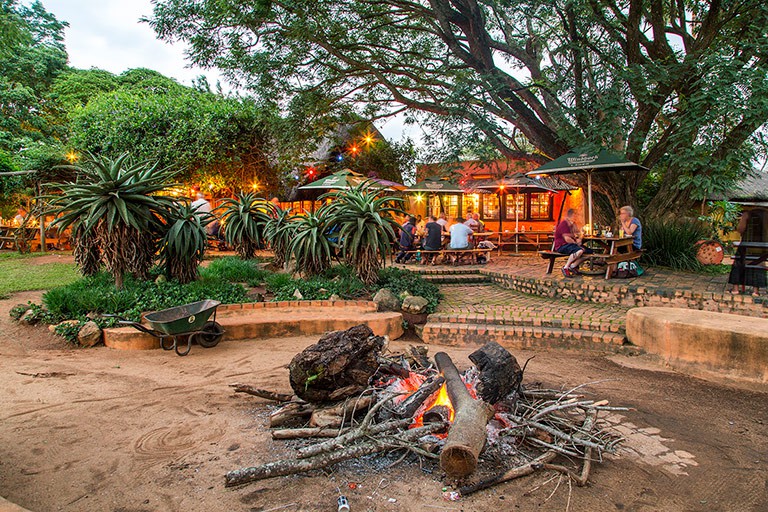
Malandela’s is just the spot for a drink, or a meal, or both.
Eating and drinking in Swaziland
eDladleni Restaurant is on the cusp of the Ezulwini Valley. Authentic Swazi meals are served by owner Delores Godeffroy’s whose mission is to revive Swazi cultural dishes – ‘slow food’ with a contemporary twist. ‘I go back to find what people were eating and then I bring it up to date by fine tuning here and there.’ There’s lots to try: from chilled maganu (amarula), freshly pressed waterberry fruit juice (inconzi) to Umhlololwane nomakhowe, a seared beef fillet with fresh garden mushrooms.
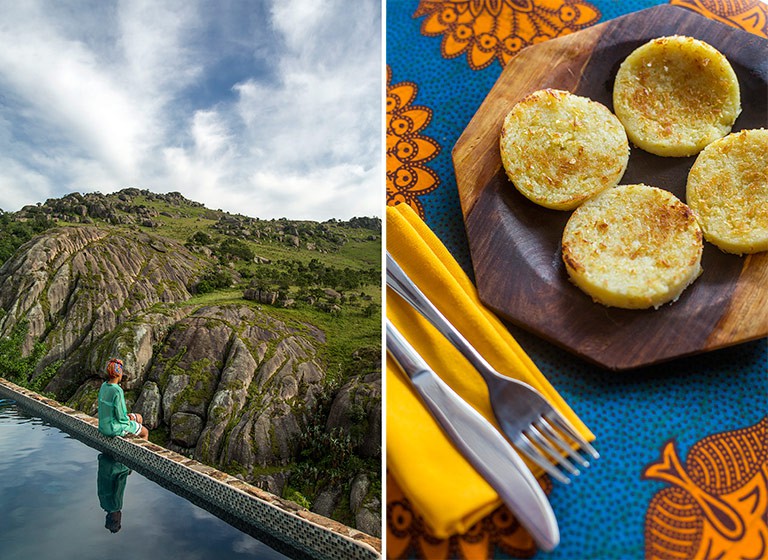
LEFT A time of contemplation at Ematjeni Luxury Bed & Breakfast enveloped by mountains. RIGHT Corn bread – a Swazi tradition at eDladleni Restaurant.
Malandela’s Restaurant & Pub has got heart: from its enthusiastic staff, to the beautiful views of the lawns to the hearty, soul food. There’s a range of options, from curries (check out its curry night) to prawns and savoury pancakes. The daily menu changes regularly. The setting is lovely, on a farm, and people can sit indoors or out, on simple benches and slatted tables.
Beer Sibebe is the local beer. It is a light lager that lacks character, but I wasn’t completely disappointed I’d tried it. It’s available countrywide. But also look out for Swaziland’s first craft beers from Thunderbolt Brewery, produced by the owner of Malandela’s, Peter Thorne. It offers a range of beers, but try the Swazi Pale Ale.
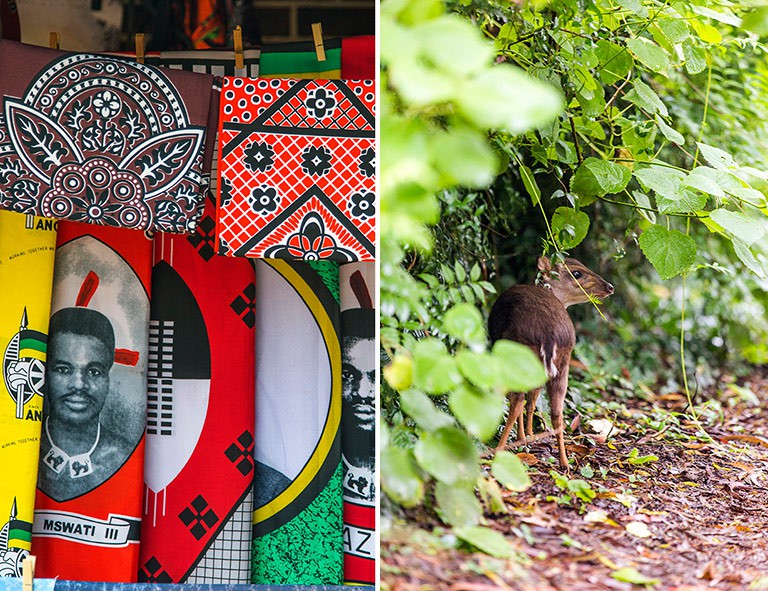
LEFT Brightly coloured Swazi fabric at the street market in Manzini. RIGHT animals co-exist with humans at Reilly’s Rock Hilltop Lodge.
Things to do in Swaziland
Swazi Candles makes beautiful and unique candle sculptures. Visitors can watch them being made and then buy them.
Ngwenya Glass has a range of African animals handmade and blown from recycled glass as well as fine homeware products.
Where to stay in Swaziland
Reilly’s Rock Hilltop Lodge is located in the Mlilwane Wildlife Sanctuary and is pure bliss. The cottages are secluded and surrounded by thick, tropical marshland. Down Gran’s Self-Catering Cottage can sleep up to seven and has a fantastic view. There’s a roomy lounge (with a sleeper couch) and long dining- room table, large decked-out kitchen, two en-suite bedrooms, a braai area and plenty of seating in the garden. You can feed bushbabies on the roof of the reception before tucking into dinner in the boma. From R890 per person (dinner included).
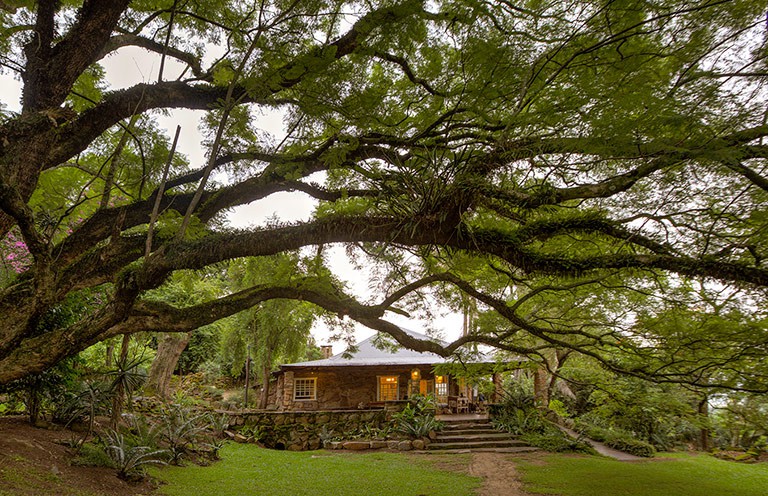
Reilly’s Rock Hilltop Lodge is like an enchanted forest out of a fairytale. The lodge is located in the tranquil Mlilwane Wildlife Sanctuary where a myriad of birds sing. The area is steeped in history.
Beehive Villages is also inside the Mlilwane Wildlife Sanctuary and guests can stay in an original Swazi grass hut enclosed by reed fencing. The huts are surprisingly big with a choice of a single bed, a double, or mixed. Some can fit up to four people. From R390 per person.
Malandela’s Bed & Breakfast in Malkerns in Manzini is both beautiful and convenient: there’s a restaurant, Internet cafe, adventure company, indigenous gardens and a live venue – House on Fire – on the same property. R670 for two sharing.
Ematjeni, or Place of Rocks, is luxurious. Carpets in the rooms feel like foam, the bathrooms are queenly, and views – they stretch far, looking out onto the Mbuluzi Gorge and the Sibebe Rock (the largest granite outcrop in the world). The residence itself is like an old family home, rooms are very spacious, all with balconies. It is a good base from which to hike (caters for various fitness levels), and other activities, such as horse-riding and white-water rafting, can be arranged. Rates from R1500 per room per night, and a tourism levy of R10 per person per night. Important: there is no credit card facility.
This article first appeared in the May 2015 issue of Getaway magazine.
All prices were correct at time of publication, but are subject to change at each establishment’s discretion. Please check with them before travelling.
